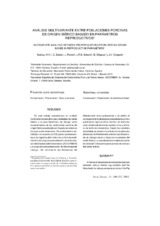Mostrar el registro sencillo del ítem
Análisis multivariante entre poblaciones porcinas de origen ibérico basado en parámetros reproductivos
| dc.contributor.author | Delgado-Bermejo, J.V. | |
| dc.contributor.author | Suárez, M.V. | |
| dc.contributor.author | Sereno, José Robson Bezerra | |
| dc.contributor.author | Forero, J. | |
| dc.contributor.author | Barba Capote, C.J. | |
| dc.contributor.author | Diéguez, E. | |
| dc.date.accessioned | 2010-04-12T09:25:39Z | |
| dc.date.available | 2010-04-12T09:25:39Z | |
| dc.date.issued | 2002 | |
| dc.identifier.issn | 1885-4494 | |
| dc.identifier.uri | http://hdl.handle.net/10396/2907 | |
| dc.description.abstract | In this work we present a multivariate analysis between various Iberian pig varieties and the Manchado de Jabugo as representative of the Pig populations of Iberian origin exploited in Spain in extensive production systems. For them we have studied a sample of 558 parturition belonging to the records of the kernel of control of yields of the selection program of the Breeders Association of the Iberian Pig (AECERIBER) and to the conservation program of the Manchado de Jabugo. They were calculated the Mahalanobis distance between populations and was accomplis-hed the corresponding cluster basing us on the reproductive parameters number of total piglets, number of born piglets alive and number of weaned piglets. Our results indicate for these populations according to the variables studied the high Mahalanobis distances existence between the Manchado de Jabugo breed as compared to all the varieties of the Iberian pig, and some distances moderated between the variety Torbiscal respect to the rest of the Iberian pig varieties. | en |
| dc.description.abstract | En este trabajo presentamos un análisis multivariante entre diversas variedades del cerdo Ibérico y la raza Manchado de Jabugo como representantes de las poblaciones porcinas de origen Ibérico explotadas en España en sistemas de producción extensivos. Para ellos hemos estudiado una muestra de 558 partos pertenecientes a los registros del núcleo de control de rendimientos del programa de selección de la Asociación de Criadores del Cerdo Ibérico (AECERIBER) y al programa de conservación del Manchado de Jabugo. Se calcularon las distancias de Mahalanobis entre poblaciones y se realizó el correspondiente dendograma basándonos en los parámetros reproductivos número de lechones total, número de lechones nacidos vivos y número de lechones destetados. Según las variables estudiadas se observa la existencia de elevadas distancias de Mahalanobis entre la raza Manchado de Jabugo frente a todas las variedades del cerdo Ibérico, y unas distancias moderadas entre la variedad Torbiscal respecto al resto de estirpes del cerdo Ibérico. | es_ES |
| dc.format.mimetype | application/pdf | es_ES |
| dc.language.iso | spa | es_ES |
| dc.publisher | Universidad de Córdoba, Servicio de Publicaciones | es_ES |
| dc.rights | https://creativecommons.org/licenses/by-nc-nd/4.0/ | es_ES |
| dc.source | Archivos de zootecnia 51 (193), 249-252 (2002) | es_ES |
| dc.subject | Raza autóctona | es_ES |
| dc.subject | Preservación | es_ES |
| dc.subject | Conservación | es_ES |
| dc.subject | Cerdo ibérico | es_ES |
| dc.title | Análisis multivariante entre poblaciones porcinas de origen ibérico basado en parámetros reproductivos | es_ES |
| dc.title.alternative | Mutivariate analysis between pig populations from iberian origin based in reproductive parameters | en |
| dc.type | info:eu-repo/semantics/article | es_ES |
| dc.relation.publisherversion | http://www.uco.es/organiza/servicios/publica/az/az.htm | es_ES |
| dc.rights.accessRights | info:eu-repo/semantics/openAccess | es_ES |

